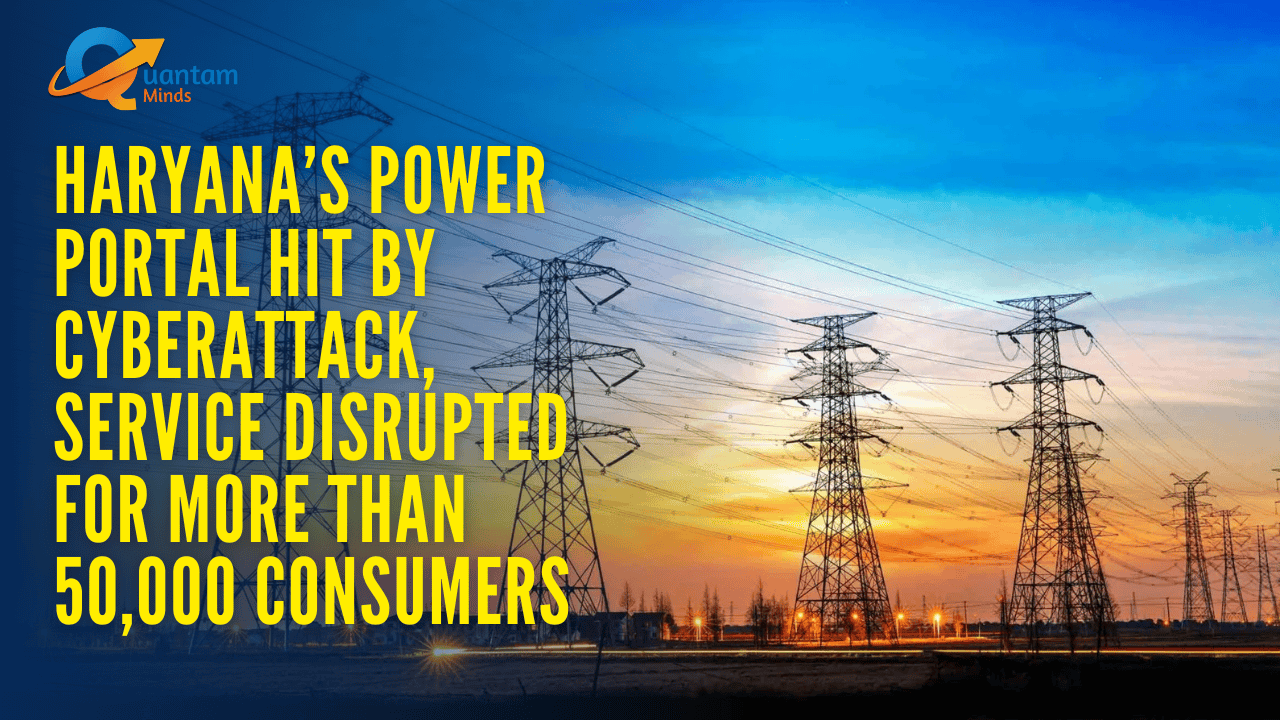Listen to This Article
Chandigarh, May 21, 2025 — In a major disruption to the state's digital infrastructure, the official power distribution portal of Haryana has fallen victim to a severe cyberattack, rendering online services unavailable to over 50,000 electricity consumers across multiple districts.
According to officials from the Uttar Haryana Bijli Vitran Nigam (UHBVN) and Dakshin Haryana Bijli Vitran Nigam (DHBVN), the attack occurred late Monday night, targeting backend servers and databases that handle bill payments, complaint redressal, new connection applications, and real-time energy tracking.
Critical Consumer Services Disrupted
The cyberattack has left thousands of residential and commercial consumers unable to:
- Pay electricity bills online
- Lodge service complaints
- Track power consumption
- Apply for new connections or upgrades
Officials confirmed that data integrity is under review, though there is no immediate evidence of customer data theft. Cybersecurity teams, along with the State IT Department and CERT-In (Indian Computer Emergency Response Team), have been deployed to investigate and contain the breach.
What the Authorities Say
“We are treating this as a high-priority incident. All consumer services through the online portal have been temporarily suspended until we ensure complete security of the systems,” said a senior DHBVN official.
He further added that while offline bill payments at local offices are still functional, the inconvenience caused to digitally dependent consumers is being acknowledged.
Possible Ransomware Attack?
Sources suggest that the nature of the breach indicates a potential ransomware attack, where hackers may have encrypted critical files and demanded payment for unlocking access. However, officials have neither confirmed nor denied this, citing an ongoing investigation.
Public Reaction and Helpline Support
Consumers expressed frustration on social media about failed bill payments and unresponsive customer care lines. In response, the power corporations have set up emergency helplines and are encouraging consumers to visit local offices for urgent needs.
- Helpline Numbers:
- UHBVN: 1912 / 1800-180-1550
- DHBVN: 1800-180-4334 / 1912
- UHBVN: 1912 / 1800-180-1550
Restoration Timeline
Although no specific timeline has been provided, authorities assure that the services will be restored in phases once the threat is fully mitigated. A cybersecurity audit of all related digital assets is also being planned to prevent future incidents.
Growing Cybersecurity Concerns
This incident marks one of the most significant cyberattacks on a public utility in Haryana. It highlights the urgent need for robust cybersecurity frameworks in critical infrastructure, especially as more public services transition to online platforms.
This incident is alarming and highlights several critical issues:
1. Public Infrastructure Vulnerability
Government and utility portals often lag behind in cybersecurity compared to private enterprises. The Haryana power portal breach exposes how underprepared many state-run digital systems are when it comes to modern cyber threats like ransomware or DDoS attacks.
2. Impact on Common Citizens
The attack directly affects over 50,000 users — many of whom rely heavily on digital services for bill payments and issue resolution. For elderly users or rural consumers, navigating alternate solutions like in-person visits can be a major inconvenience. The problem goes beyond technology; it’s a breakdown in serving the community effectively.
3. Need for Cyber Resilience
This should serve as a wake-up call for governments across India to:
- Conduct regular cybersecurity audits
- Use AI-based threat detection
- Maintain secure and up-to-date backup systems
- Train staff in cyber hygiene and incident response
4. Transparency & Communication
One positive is that authorities acted quickly to acknowledge the issue and involved CERT-In. But moving forward, real-time public communication is essential. Many citizens rely on social media and SMS for alerts—these should be used actively during such crises.
5. Cybersecurity in Critical Sectors
This is part of a larger global trend. As power grids, water supply systems, and transportation go digital, they become more exposed to cyber risks. Haryana’s case could be a precursor to bigger disruptions if not taken seriously nationwide.
Pros (Indirect or Long-Term Positives)
1. Increased Awareness of Cybersecurity
- This incident puts a spotlight on the vulnerabilities in government systems.
- It may push state and national authorities to take cybersecurity more seriously, leading to stronger digital infrastructure.
2. Push for System Upgrades
- Legacy software and outdated digital platforms may now be reviewed and replaced with more secure, modern solutions.
3. Emergency Preparedness Improvement
- The breach could lead to the creation of better incident response plans, backup protocols, and disaster recovery systems.
4. Policy and Regulation Boost
- It might encourage new cybersecurity policies or stricter compliance standards for government and utility services in India.
5. Public Engagement and Vigilance
- Citizens may become more aware of digital safety and the risks of relying solely on online services without backup options.
Cons (Immediate and Long-Term Negatives)
1. Disruption to Public Services
- Over 50,000 consumers faced issues with bill payments, complaints, and other services.
- This is especially problematic for people with limited access to physical offices or who rely on online services.
2. Loss of Public Trust
- A major breach like this reduces public confidence in government-run digital systems.
3. Potential Data Breach
- While not confirmed, there's always a risk of data theft or manipulation in such attacks, especially if personal details, billing info, or Aadhaar-linked data is involved.
4. Economic Impact
- Late bill payments, business interruptions, and additional resources for restoration all carry economic costs.
5. Encouragement to Cybercriminals
- If the attackers were successful or remain unidentified, it might embolden other hackers to target public infrastructure.
6. Reputational Damage
- Haryana’s digital governance image suffers, especially if this event gains national media traction or repeats in the future.
Conclusion
While the immediate impact is clearly negative, this cyberattack could serve as a turning point if it drives:
- Long-term investment in cybersecurity,
- Transparency in digital governance,
- Better preparedness for future threats.
It’s a painful but potentially necessary lesson for digital India.
he cyberattack on the Haryana Power Portal is not just a one-time disruption — it has the potential to trigger long-term consequences and changes across various domains. Here’s a detailed look at what this event could lead to in the future:
1. Policy and Governance Changes
- Stronger Cybersecurity Policies: The central and state governments may introduce new guidelines or legislation focused on critical infrastructure protection.
- Mandatory Cyber Audits: Utilities and government departments could be required to undergo periodic security audits.
- Creation of Cybersecurity Task Forces: Dedicated state-level cybersecurity teams might be established to monitor and respond to threats in real-time.
2. Improved Digital Infrastructure
- Upgrading Legacy Systems: Old portals and databases may be replaced with more secure, cloud-based, AI-monitored systems.
- Implementation of Redundant Systems: Backup systems (mirrors and failovers) could be developed to keep services running during cyber incidents.
- Advanced Encryption and Authentication: Multi-factor authentication and end-to-end encryption for portals handling sensitive data might become mandatory.
3. Economic and Service Impact
- Revenue Disruption: Delay in bill collection and system outages could affect revenue cycles, especially if repeated in future.
- Service Backlogs: Once systems are restored, there may be a backlog of pending services, complaints, and billing corrections.
- Insurance Premium Increases: Government and public utilities might need to purchase or upgrade cyber insurance, increasing operational costs.
4. Public Behavior and Trust
- Loss of Digital Trust: Citizens may become more hesitant to rely on government portals for sensitive transactions unless visible improvements are made.
- Demand for Transparency: The public and media may push for more transparency and accountability in how cyber incidents are handled.
5. Inter-State and National Implications
- Other States Will Take Notice: This breach could prompt neighboring states to preemptively audit their own portals, avoiding similar risks.
- National Security Discourse: Cyberattacks on utilities may become part of India’s internal security discussions, involving agencies like CERT-In and NTRO more actively.
6. Opportunities for Skill Development
- Cybersecurity Hiring Surge: Government and utility sectors may ramp up recruitment for cybersecurity roles.
- Public Sector Training Programs: Existing IT staff could undergo training on incident response, data protection, and threat detection.
- Collaboration with Private Sector: State agencies may collaborate with top tech firms or cybersecurity companies to build more resilient systems.
7. Possibility of Repeat or Escalated Attacks
- Increased Targeting: If attackers were successful this time, it may signal to cybercriminals that critical infrastructure is an easy target.
- More Sophisticated Future Attacks: Hackers may evolve tactics — like attacking smart meters, grid control systems, or consumer apps linked to electricity usage
✅ How to Turn This Into a Positive Turning Point
- Swift and transparent response
- Investment in cybersecurity infrastructure
- Public confidence-building measures
- Proactive simulations and mock drills
- Nationwide digital hygiene awareness campaigns
Incident Overview
On May 7, 2025, UHBVNL's official website suffered a cyberattack, disrupting critical online services such as new electricity connections, bill payments, and complaint registrations. Over 50,000 consumers across multiple districts were affected. The utility's core functionalities were rendered non-operational, prompting cybersecurity teams to work diligently to mitigate the breach and restore services.
Immediate Response and Challenges
- Service Disruption: Consumers seeking new power connections or attempting to access bill payments and complaint registration faced significant delays and confusion.
- Cybersecurity Measures: UHBVNL declared a cybersecurity emergency, with teams working around the clock to contain the damage. A 48-hour recovery window was anticipated, but the complexity of the attack posed challenges.
Historical Context
This isn't the first time UHBVNL has faced cyber threats. In March 2018, the utility's billing data was compromised, with hackers demanding a ransom of Rs 1 crore in Bitcoins. The attack affected billing data of over 26 lakh consumers, leading to significant operational challenges.
Potential Future Implications
- Enhanced Cybersecurity Protocols: The incident underscores the need for robust cybersecurity measures. Utilities may invest in advanced threat detection systems, regular security audits, and employee training to prevent future breaches.
- Policy Revisions: Government bodies might introduce stricter regulations and compliance standards for critical infrastructure to ensure data protection and service continuity.
- Public Trust and Communication: Transparent communication during and after such incidents is crucial. Building public trust requires timely updates and assurances about data safety and service restoration.
- Inter-Agency Collaboration: Collaboration between state utilities, cybersecurity agencies, and law enforcement can lead to more effective responses to cyber threats.
- Consumer Awareness: Educating consumers about cybersecurity, safe online practices, and alternative service channels can mitigate the impact of such disruptions.
 Unlock Your Savings Today!
Unlock Your Savings Today!
Get the best deals with unbeatable service and exclusive offers.

 Grow Your Business with Proven Digital Marketing
Grow Your Business with Proven Digital Marketing
Ready to attract more customers and outshine your competition? Our tailored digital marketing strategies help you rank higher, generate qualified leads, and build a brand people trust. Let’s take your business to the next level.
Digital Marketing Solutions in Leading Cities


 Disclaimer
Disclaimer
The views expressed by experts in this article are their own and do not necessarily reflect the opinions of any website, organization, institution, or affiliated entity. If you have any concerns regarding this article, please contact us at contact@quantamminds.com and also on WhatsApp
Frequently Asked Questions
What exactly happened in the Haryana power portal cyberattack?
On May 7, 2025, the official website of Uttar Haryana Bijli Vitran Nigam (UHBVNL) was hit by a cyberattack. This caused a shutdown of critical online services including electricity bill payments, new connection applications, and complaint registrations. Over 50,000 consumers across Haryana were affected.
Did the cyberattack result in any personal data theft of electricity users?
As of now, there is no confirmed evidence that consumer data was stolen. However, cybersecurity teams are still assessing the breach. Given the nature of the attack, officials are taking precautionary steps to ensure data safety and are conducting a full forensic audit.
How are affected consumers supposed to pay their bills or file complaints?
Due to the online portal being down, offline services such as bill payments and complaints at local electricity offices are still operational. Consumers can also use helpline numbers provided by UHBVNL and DHBVN for support until the portal is fully restored.
What steps is the government taking to prevent future cyberattacks?
The state has involved CERT-In and cybersecurity experts to investigate and mitigate the threat. Officials have announced plans for:
- Strengthening firewalls and encryption
- Conducting cybersecurity audits
- Implementing advanced threat detection systems
- Upgrading outdated IT infrastructure
Could similar cyberattacks happen again in the future?
Yes, unless there is a significant upgrade in cybersecurity measures, similar attacks could reoccur. Critical infrastructure like power utilities are frequent targets. That’s why government agencies and public utilities are being advised to adopt robust cybersecurity practices and prepare response protocols in advance.








 Ashwani Kumar on 2025-05-21
Ashwani Kumar on 2025-05-21





